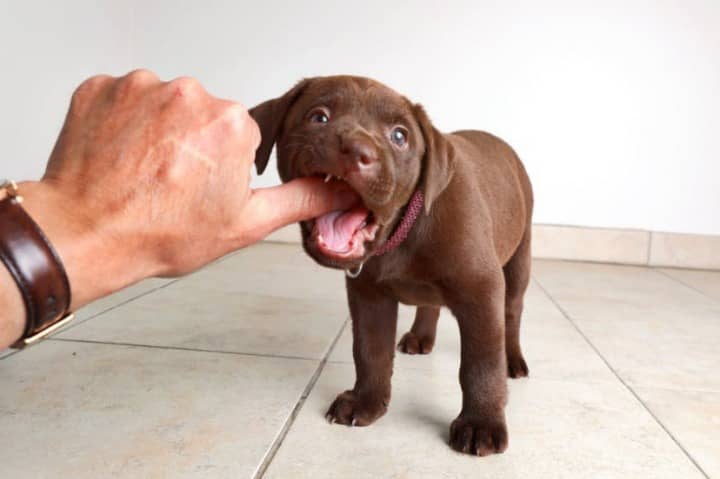In veterinary care, understanding dogs’ teething process is crucial for optimal dental health. Similar to humans, dogs also go through a period of losing their baby teeth as they transition into adulthood. This natural process, deciduous tooth replacement, allows permanent teeth eruption and development.
Consider Max, a playful Labrador Retriever puppy who recently turned four months old. His owners have noticed that he has been chewing on everything in sight and exhibiting discomfort while eating. These behaviors could be indicative of him going through the teething process.

This article explores when dogs start losing their baby teeth, the signs and symptoms associated with teething, how to support your dog during this stage, and what to do if a baby tooth doesn’t fall naturally.
Additionally, we will discuss common dental issues in dogs and stress the importance of regular vet check-ups for maintaining oral health.
Finally, we will address frequently asked questions regarding pulling loose dog teeth and conclude with essential tips for caring for your furry friend’s teeth. By following these guidelines, you can ensure that your canine companion enjoys optimal oral health.
Dogs lose baby Teeth Key Takeaways
- Dogs go through deciduous tooth replacement, losing baby teeth as they transition into adulthood.
- The teething process usually starts at 3-4 months and lasts until around seven months.
- Signs of teething in dogs include increased chewing behavior, irritability, and restlessness.
- Appropriate chew toys, cold treats, and suitable food choices can help alleviate discomfort and support dogs during teething.
Understanding the Teething Process in Dogs
The teething process in dogs involves the shedding of their baby teeth. This natural process can sometimes present difficulties for the dog and its owner.
The duration of the teething process can vary depending on various factors, including the breed and individual characteristics of the dog. Generally, puppies begin teething around three to six months, lasting until they are about six to eight months old.
During this time, puppies may experience discomfort and pain as their new adult teeth emerge and replace their baby teeth. To alleviate these difficulties, owners must provide appropriate chew toys or treats for teething puppies. These can help relieve discomfort while fulfilling the puppy’s instinct to chew.
When Do Dogs Start Losing Their Baby Teeth?
At a certain stage of their development, canine creatures undergo a natural process wherein their initial set of smaller and less permanent oral structures are gradually replaced with more robust and enduring ones. This teething process in dogs typically begins at around 3 to 4 months and continues until they are about seven months old. During this time, puppies start losing their baby teeth as the adult teeth emerge.
To create imagery in the audience’s mind, imagine a playful puppy eagerly exploring its surroundings while experiencing three distinct stages of teething:
For those looking to serve their furry companions during this phase, it is essential to provide appropriate teething remedies for dogs.
Signs and Symptoms of Teething in Dogs
Certain indications and sensations may arise during the teething process in canines, evoking a sense of empathy in observers. Teething discomfort is one of the common signs experienced by dogs during this phase. They may exhibit increased chewing behavior, as it helps alleviate the pain caused by erupting teeth.
Additionally, dogs may display irritability or restlessness due to the discomfort they are experiencing. Providing suitable teething toys can be beneficial for dogs during this time, as it satisfies their urge to chew while also relieving the teething pain. These toys should be specifically designed for teething puppies, with gentle textures on their gums.
Owners can help alleviate their dog’s discomfort and promote healthy oral development during this transitional period by offering appropriate teething toys.
How to Help Your Dog During the Teething Process
It is important to provide appropriate chew toys to help your dog during the teething process. These toys can help satisfy their natural urge to chew and alleviate discomfort.
Offering cold treats or ice cubes can also provide relief by numbing the gums and reducing inflammation. However, it is important to avoid giving them hard foods as these can potentially damage their new teeth or cause choking hazards.
Provide Appropriate Chew Toys
Appropriate chew toys can be provided to dogs to address their teething needs. During teething, puppies experience discomfort and pain as their baby teeth fall out and are replaced by adult teeth. Appropriate chew toys can help alleviate this discomfort and prevent destructive chewing behaviors.
To ensure the chew toys are suitable for your dog’s teething needs, consider the following options:
By offering appropriate indestructible chew toys during the teething process, you can satisfy your dog’s natural urge to bite and soothe their discomfort while protecting your belongings from potential damage.
Offer Cold Treats or Ice Cubes
Cold treats or ice cubes can be refreshing and soothing for dogs experiencing teething discomfort. Offering cold treats to teething puppies can provide relief by numbing their gums and reducing inflammation.
Ice cubes can also serve as a cool and satisfying chew toy, making them an excellent alternative to traditional toys that may not offer the same level of relief. It is essential to ensure that the treats or ice cubes are safe for consumption, as some ingredients may harm dogs. Therefore, it is recommended to use dog-friendly recipes or commercially available frozen treats specifically designed for canine consumption.
Additionally, supervision is crucial when giving ice cubes to prevent choking hazards and potential damage to teeth. By offering cold treats or ice cubes, dog owners can help alleviate their pets’ teething discomfort safely and enjoyably.
Avoid Hard or Tough Foods
Avoiding hard foods can help prevent further discomfort for teething dogs. During teething, puppies experience stages where their baby teeth fall out and are replaced by permanent adult teeth. Providing them with appropriate food options that are easy to chew and gentle on their developing gums is essential.
Here are some suitable food choices for teething dogs:
- Soft wet food: Opt for wet dog food that is easily digestible and does not require much chewing.
- Soaked kibble: Soaking dry kibble in water or broth can make it softer and easier to chew.
- Soft treats: Look for treats specifically designed for puppies undergoing teething.
- Frozen fruits or vegetables: Provide relief by offering frozen snacks for cold carrots, cucumbers, or apple slices.
- Prescription dental diets: Consult your veterinarian about specialized dental diets that promote oral health.
It’s important to note that dog breeds may have varying teething timelines and require individualized dietary considerations during this stage.
What to Do if a Baby Tooth Doesn’t Fall Out
If a baby’s tooth does not naturally fall out, it is important to consult with a dental professional to determine the best course of action.
Sometimes, the baby tooth may need to be extracted to prevent complications and ensure proper dental care for adult dogs. Leaving a retained baby tooth in place can lead to overcrowding or misaligning the permanent teeth as they come in. Additionally, retained baby teeth can increase the risk of tartar build-up and gum disease.
A dental professional can assess the situation and recommend appropriate treatment, which may involve extracting the retained baby tooth under anesthesia. Regular dental check-ups are essential for maintaining optimal oral health in dogs and promptly addressing any issues.
By seeking professional advice, pet owners can ensure their furry friends receive quality dental care throughout their lives.
Dental Care for Adult Dogs
Regular dental care is vital for maintaining optimal oral health in adult dogs and preventing complications such as overcrowding or misalignment of permanent teeth. Just like humans, dogs can suffer from dental issues such as tartar build-up, gum disease, and tooth decay if proper dental hygiene is not practiced.
One important aspect of dental care for adult dogs is regular teeth cleaning. This involves brushing your dog’s teeth with specially formulated dog toothpaste and toothbrush. Brushing your dog’s teeth at least 2-3 times a week is recommended to remove plaque and prevent the formation of tartar.
Additionally, providing chew toys or treats that promote healthy chewing can help keep their teeth clean by reducing plaque build-up. Regular veterinary check-ups are also crucial for monitoring your dog’s oral health and addressing any dental issues promptly.
By incorporating these practices into their routine, owners can ensure their furry companions maintain good oral hygiene and overall well-being.
Common Dental Issues in Dogs
A dog’s dental health can become a nightmare when common issues such as tartar build-up, gum disease, and tooth decay start taking over their mouths. These problems can cause discomfort and pain for dogs, affecting their overall well-being.
To prevent these issues, it is important to understand the teething process in puppies and provide appropriate dental care throughout a dog’s life. During teething, puppies lose their baby teeth as permanent teeth emerge.
Regular dental cleaning for dogs removes plaque and prevents tartar build-up. This can be achieved through professional cleanings by veterinarians or at-home dental care routines recommended by experts.
By addressing these common dental issues in dogs, we can ensure they have healthy mouths and promote their overall quality of life.
Importance of Regular Vet Check-ups
During regular vet check-ups, dental issues in dogs can be detected early on, allowing for prompt treatment and prevention of further complications. One important aspect that veterinarians assess during these check-ups is the teething timeline of dogs.
Dogs typically start losing their baby teeth around 3 to 4 months, usually completed by around six months. By monitoring this timeline, vets can ensure that the adult teeth are growing properly and address any abnormalities or delays in tooth eruption.
Additionally, managing teething discomfort is another crucial aspect covered during these check-ups. Vets may provide recommendations on appropriate chew toys or suggest safe pain relief methods to help alleviate any discomfort experienced by the dog during this process.
Can I Pull My Dog’s Loose Tooth?
One common question pet owners may have is whether they can extract their dog’s loose tooth at home. While it may be tempting to try and pull a loose tooth from your dog’s mouth, it is important to remember that tooth extraction should only be performed by a trained veterinarian.
Here are three reasons why attempting to pull your dog’s loose tooth at home is not recommended:
By allowing a professional veterinarian to handle tooth extraction, you can ensure the best possible outcome for your beloved pet.
Frequently Asked Questions
How many sets of teeth do dogs have in their lifetime?
Dogs have two sets of teeth in their lifetime: a deciduous set, also known as baby teeth, and a permanent set. The number of teeth varies among breeds but typically ranges from 42 to 44. Signs of teething in dogs include excessive chewing and drooling.
Do all dogs go through a teething process?
Dogs typically experience a teething process characterized by a timeline during which their adult teeth replace the baby ones. To alleviate discomfort, providing appropriate teething toys can be beneficial in serving their needs.
Can dogs experience discomfort or pain during teething?
During teething, dogs may experience discomfort or pain. Providing appropriate teething toys can help alleviate their symptoms and promote healthy chewing habits. It is essential to monitor their behavior and consult a veterinarian for concerns about their well-being.
Are there any risks or complications associated with a baby tooth not falling out?
Retaining baby teeth in dogs can lead to risks and dental issues. These include overcrowding, misalignment, tartar build-up, gum inflammation, and an increased risk of periodontal disease if not addressed promptly by a veterinarian.
How often should I brush my dog’s teeth?
To ensure optimal oral hygiene for your dog, it is recommended to brush their teeth regularly. Training your dog to enjoy tooth brushing can be achieved through positive reinforcement techniques. Additionally, natural remedies can be used for dog dental care.
Conclusion
To ensure your canine companion’s long-lasting health and vitality, it is crucial to prioritize the maintenance and care of their precious pearly whites. Caring for your dog’s teeth goes beyond just brushing; it also involves proper gum care.
Neglecting gum health can lead to various dental diseases in dogs, such as periodontal disease and gingivitis. Regularly inspecting your dog’s gums for signs of redness, swelling, or bleeding is essential. Additionally, providing appropriate chew toys can help maintain healthy gums by reducing plaque build-up and stimulating blood circulation.
Donate Today and Help Us Save More Dogs



